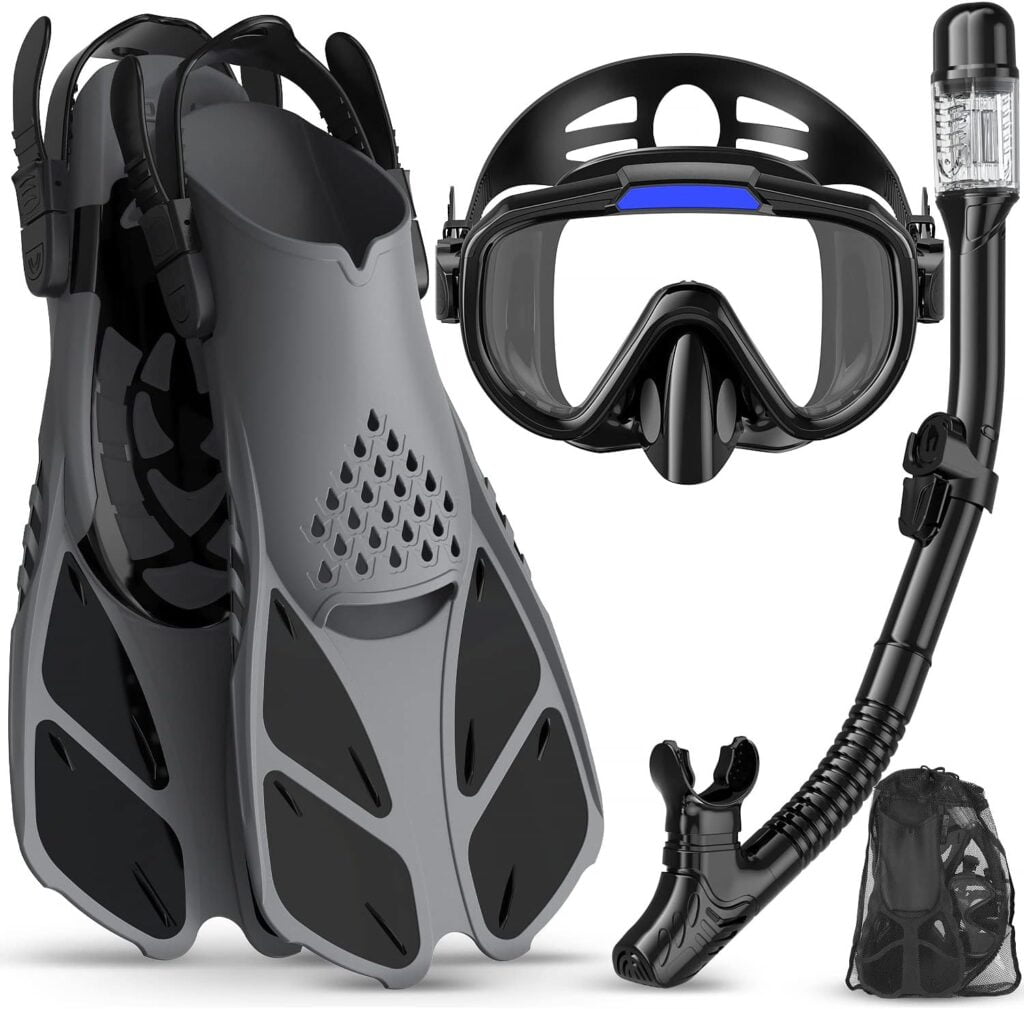Introduction
Snorkeling is a popular underwater adventure activity. It involves mostly floating and you do not need to be an expert swimmer. You float on the surface of the water, so you can see all the amazing marine life under the sea without going too deep. For this, you just wear a mask over your eyes and nose and have a special tube (snorkel) in your mouth. This tube lets you breathe. The primary purpose of snorkeling is to observe underwater life, including fish, turtles, coral reefs, and other marine creatures, in their natural habitat. It’s like having a front-row seat to the underwater show!
Here, we will discuss all about Snorkeling. We will introduce you to the basics of this activity and explore how Snorkeling works. also the gear you need and offer some useful tips for beginners. So, let’s go and begin our underwater fun.

What is Snorkeling?
Snorkeling is a real magic show! It gives you an experience of a wonderland. You float and watch the fish go by. See vibrant coral reefs that look like an artist’s palette. The colors are incredible, like a living rainbow. You can even chat with the turtles if you’re lucky! You can spy on hidden creatures like seahorses and starfish. There is no need for scuba gear; a snorkel, mask, and fins do the trick. It’s a peaceful, magical world beneath the waves. All you need is an adventurous heart and a love for the ocean.
The Equipment You Need
To begin your snorkeling journey, you’ll need some essential gear:

- Snorkel Mask: This covers your eyes and nose, and creates a watertight shield. It ensures you can see underwater.
- Snorkel Tube: A breathing tube with a mouthpiece. Put one end in your mouth and the top end remains above the water. It provides constant breathable air. No need to come up for air constantly.
- Fins: These help you to move efficiently through the water.
- Wetsuit or Rash Guard: Keeps you warm and protects your skin from the sun.
- Life Jacket: a life jacket is always recommended especially for beginners
How Does Snorkeling Work?
When you lie flat on the water’s surface with your snorkel gear, you become buoyant, like a floating feather. The snorkel tube lets you breathe underwater, and you stay afloat effortlessly. Your snorkel becomes your air tunnel to the underwater world. It’s designed so you can breathe through it while your face is submerged. Snorkeling is not just fun; it’s also a fascinating science adventure. Dive in, explore, and experience the magic of the underwater world.
lets reveal the science secrets behind snorkeling:
Science Secret #1: Buoyancy – Fins make you float, and that’s because of buoyancy. It’s like having a friend helping you stay up in the water.
Science Secret #2: Breathing – The snorkel lets you breathe without lifting your head. You inhale air from above the water while your face stays in the sea.
Science Secret #3: Clear Vision – The mask is your underwater window. It’s designed in a way that keeps water out and lets you see the underwater world clearly.
Snorkel Techniques for Beginners
Breathing: Practice breathing through the snorkel in shallow water before going into deeper areas. When breathing through the snorkel, take slow, deep breaths. Avoid quick, shallow breaths to conserve energy.
Floating: Lie face down in the water with your snorkel in your mouth and your fins submerged. Extend your arms forward and use a gentle scissor kick with your fins to maintain buoyancy. Use your hands and fins to maintain balance.
Clearing the Mask: Learn how to clear water from your mask by tilting your head back and exhaling through your nose.
Equalizing Pressure: As you go into deeper water, you might feel pressure in your ears. To equalize, pinch your nose shut and gently blow through it while keeping your mouth closed. This helps equalize the pressure inside your ears with the surrounding water pressure.
Know Your Limits: Don’t push yourself too hard. If you feel tired, return to shallower waters or take a break.
Popular Snorkeling Destinations
Selecting the perfect snorkeling spots around the world is easy. look for areas with calm-clear water and abundant marine life. Popular snorkeling destinations include tropical reefs, marine reserves, and calm bays. Before you go Do some internet research. Check the local weather forecast. Sunny days with mild winds are perfect for snorkeling. Here are some of the most famous snorkeling spots around the World:
- Great Barrier Reef – Queensland, Australia
- Molokini Crater – Maui, Hawaii, USA
- Coral Triangle – Southeast Asia (Indonesia, Philippines, Malaysia, Papua New Guinea, Timor-Leste, and Solomon Islands)
- Raja Ampat Islands – West Papua, Indonesia
- Bora Bora Lagoon – French Polynesia
- Maldives – Indian Ocean
- Ningaloo Reef – Western Australia
- Belize Barrier Reef – Belize
- Tubbataha Reef – Palawan, Philippines
- Galápagos Islands – Ecuador
- Komodo National Park – Indonesia
- Fiji Islands – South Pacific
- Fernando de Noronha – Brazil
- The Similan Islands – Thailand
- Roatán – Honduras
- Bonaire- Caribbean
- Puerto Rico – Caribbean
- Croatia – Adriatic Sea
Benefits of Snorkeling
Snorkeling offers numerous benefits, including:
- Nature’s therapy – Snorkeling ensures stress relief and relaxation. It is the ultimate stress dissolver.
- Full-Body workout – It’s not just a therapy, it’s a full-body physical exercise. Snorkeling flexes muscles.
- Aquatic exploration – Every dive opens a new chapter of a fantasy. Be an aquatic explorer.
- Family bonding – Snorkel together, stay together. It’s a family bonding adventure.
- Dive into happiness – Snorkeling guarantees a mood lift with every dive. So dive not just into water but into happiness.
Snorkeling Safety Tips
Here are some tips to enhance your snorkeling experience
- Buddy up – Safety first. Snorkel with a buddy, so you can look out for each other. Sea adventures are better together.
- Fit That Mask Right – Snug masks keep water out. A comfy face is a happy face. To prevent your mask from fogging up, use an anti-fog solution
- Breathe well – Practice proper breathing techniques with your snorkel.
- Save your energy – Stay relaxed and conserve energy in the water.
- Avoid trying extra – Don’t push yourself too hard. If you’re tired or uncomfortable, head back to shore.
- Be patient – Stay patient while observing marine life. It’s not a race. Snorkel at your pace, enjoy the aquatic grace.
- Be a good guest – Remember, you’re a guest in their world. Don’t touch, feed, or disrupt marine animals. Maintain a safe distance from coral reefs. never stand on or touch the reef, as it is very fragile and can easily cut you.
- Avoid alcohol consumption – Do not consume alcohol prior to water activities, as it will cause you to become dehydrated.
- Apply good Sunscreen – Get a sunscreen labeled “water-resistant.” Be a conscious snorkeler. Opt for reef-friendly sunscreen to protect both your skin and underwater ecosystems.
- Emergency signs – Thumbs up is joy, not an SOS. Communication is key.
- Leave No trace – Coral reefs are not a souvenir shop. Leave only bubbles, take only memories.
Common Misconceptions About Snorkeling
As we have discussed all about Snorkeling experience. There are a few common misconceptions about snorkeling:
- Expert Swimmer Required? – No, you don’t have to be an Olympic swimmer. Basic swimming skills are usually enough for snorkeling.
- Deep Dives Only? – Not at all. Snorkeling can be amazing near the surface. Many creatures hang out there.
- Breathing Hard? -Relax! Breathing with a snorkel is easy. It’s like sipping a drink through a straw.
- Scary Sharks Everywhere? – Sharks don’t crash every snorkeling party. They usually keep their distance, and encounters are rare.
- It’s Not for Kids? – Wrong! Kids love snorkeling. Just ensure they’re comfortable in the water and follow safety rules.
- Can’t Wear Glasses? – No worries. You can get special masks with prescription lenses.
- You Need Loads of Gear? – Gear is your underwater sidekick, not a puzzle. Mask, snorkel, fins – easy peasy!
- Need Super Strength to Snorkel? – Nope! Snorkeling is more about floating and enjoying, not flexing.
- Exotic Locations Only? – Snorkeling isn’t picky. From ponds to tropical oceans, it’s a game you can enjoy anywhere.
- Strictly Summer Activity? – Think beyond summer! Snorkel in any season; fish don’t check the calendar.
- Only for Adventure Junkies? – Snorkeling is a light adventure activity – no extreme stunts, just sea smiles.
Conclusion
Well you know Snorkeling isn’t, about swimming. It’s, like immersing yourself in a surprising world of beauty and colors. When you put on your gear and let yourself float you’ll find yourself getting lost in the life below. It sparks your curiosity. Fills you with a sense of wonder. Snorkeling creates memories that will stay with you forever. Happy snorkeling!
Frequently Asked Questions
1. Is snorkeling difficult to learn?
No, snorkeling is relatively easy to learn. You don’t need to be an expert swimmer. With the right equipment and some basic techniques, anyone can enjoy snorkeling.
2. Can I wear glasses while snorkeling?
If you wear glasses, you can get prescription masks that allow you to see clearly underwater. These masks are a great solution for those with vision impairments.
3. Are there age restrictions for snorkeling?
There are no strict age restrictions for snorkeling, but it’s essential to ensure that children are comfortable in the water and can follow safety guidelines. It’s a great family activity.
4. What is the best time for snorkeling?
The best time for snorkeling depends on your chosen location. Generally, calm and clear conditions are ideal, so check the local climate and ocean conditions before you go.
5. Is snorkeling safe for the environment?
Snorkeling can be safe for the environment if done responsibly. Make sure to follow guidelines on protecting marine life and coral reefs to minimize your impact on the ecosystem


